人称代词名词所有格
- 格式:pdf
- 大小:154.61 KB
- 文档页数:8
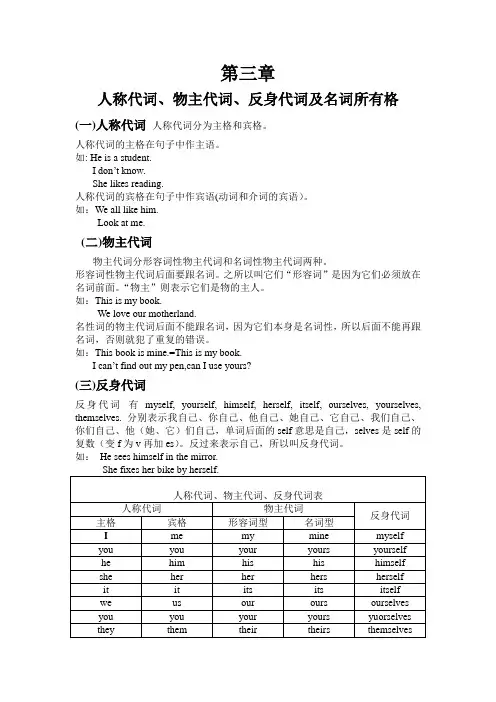
第三章人称代词、物主代词、反身代词及名词所有格(一)人称代词人称代词分为主格和宾格。
人称代词的主格在句子中作主语。
如: He is a student.I don’t know.She likes reading.人称代词的宾格在句子中作宾语(动词和介词的宾语)。
如:We all like him.Look at me.(二)物主代词物主代词分形容词性物主代词和名词性物主代词两种。
形容词性物主代词后面要跟名词。
之所以叫它们“形容词”是因为它们必须放在名词前面。
“物主”则表示它们是物的主人。
如:This is my book.We love our motherland.名性词的物主代词后面不能跟名词,因为它们本身是名词性,所以后面不能再跟名词,否则就犯了重复的错误。
如:This book is mine.=This is my book.I can’t find out my pen,can I use yours?(三)反身代词反身代词有myself, yourself, himself, herself, itself, ourselves, yourselves, themselves. 分别表示我自己、你自己、他自己、她自己、它自己、我们自己、你们自己、他(她、它)们自己,单词后面的self意思是自己,selves是self的复数(变f为v再加es)。
反过来表示自己,所以叫反身代词。
如:He sees himself in the mirror.(四)名词所有格名词所有格表示所属关系,就是“……的”的表达方式。
如:玛丽的儿子Mary’s son.学校的大门the gate of the school名词所有格可分为三种:1、有生命名词所有格2、无生命名词的所有格①无生命名词所有格一般用“of+名词”的结构表示。
如:the gate of the school 学校的大门the door of the classroom 教室的门②有些表示时间、距离以及国家等无生命的名词,可以在词尾加’s或’如:a、表时间:today’s newspaper (今天的报纸)b、表距离:ten miles’ distance (十英里的距离)c、表国家、城市等实体:China’s future (中国的未来)3、双重所有格双重所有格由“of+名词所有格”如:a friend of my father’s 我爸爸的一个朋友或“of+名词性物主代词”如:a friend of mine 我的一个朋友(五)用下列词的适当形式填空1. Who is ______( they ) teacher?2. ______( he ) name is Tom .3.This is _____ (I) pen.4. Look at _____( I).5. What’s ______ (you ) name?6. The teacher ask ____ ( you ) to read the book.7. Who is _____ ( he)?8. I like ____ ( he ).9. This is ____( he ) mother.10. The beautiful girl is ______( she ) sister.11. _____ (they ) are my classroom.12. Look at _____ ( they ) . _____ ( they ) are so strong .13. The football is _____ ( they ).14. The pretty woman is _____ ( we) teacher.15. _____ ( we) are good friends.16. Let _____ (we) sing a song together.17. ____ (I) have two big eyes .18. What color are _____( you ) eyes ?19. _____ (I)eyes are blue.20. _____ ( they ) teacher is Tom .(六)选择1> This is _________A: Jack’s T-shirt B: Jack’T-shirt C: T-shirt of Jack2>That is __________A: Doris’ book B: book of Doris C: book to Doris3>These are __________A: drivers’s cars B: drivers’ cars C: cars to drivers4> Those are ________A: mothers’ bags B: mothers’s bags C: bags of mothers5> This is _______A: question ’s answer B: the answer to the question C: the answer of question 6>This is _________A: classroom’s door B: door to classroom C: the door of the classroom7> These are ______A: the bag of the bosses B: bosses’s bags C: bosses’ bags8> This is ______A: the key of the door B: the door’s key C: the key to the door9> ______ is on the desk.A: Kim’s pen .B: Kim’s pen C: the pen of Kim10>_____ is over there .A: My mother’es dress B: My mother’s dress C:The dress of my mother课后练习一、用所给单词适当形式填空1. ________ am a student . _______name is Peter. The book is _______.(I)2. ______ are in China. These are not _______coats. ______ are over there.(their)3. ________ (who) pen is this. I think it’s ________(Bill)4. The book is _________(Mary and Jane)5. The pens are the _________(students)二. 用人称代词填空:1. Tell ___(我们)how to get there.2. Put ___(它们)there.3. ___(他们)say ___(她)is very clever.4. Who is there? It’s ___(我).5. What time is ___? ___’s 12o’clock.6. How far is ___ to the zoo?7. ___ is so cold today.8. Tell ___(我)how far is ___ from Shanghai to Nanking.9. ___’s damp and cold. ___ think ___’s going to rain.10. Show ___ how to do ___.三. 用物主代词填空:1. Is this ___(你的)classroom? No, it’s not ___(我们的). It’s ___(他们的).2. ___(他的)father is a teacher and ___(她的)is an engineer.3. ___(谁的)keys are these? —They are ___(他的), not ___(我的).4. This isn’t ___(我的)car; ___(我的)is being repaired.5. Is the coat ___(你的)or ___(她的)? It’s ___(我的),not ___(她的).6. ___(她的)views of life and very different from ___(我们的).7. This is ___(我的)umbrella and that one is ___(你的).8. This coat of ___(你的)is much nicer than ___(我的).9. Those ties of ___(他们的)must be more expensive than ___(我们的).10. I like ___(你的)better than ___(她的).四. 用反身代词填空:1. The old man lives by ______.2. I am sure I can do it all by _______.3. Mary is old enough to take care of ______.4. Can you carry this box upstairs by _______.5. We can finish this task by _______.。
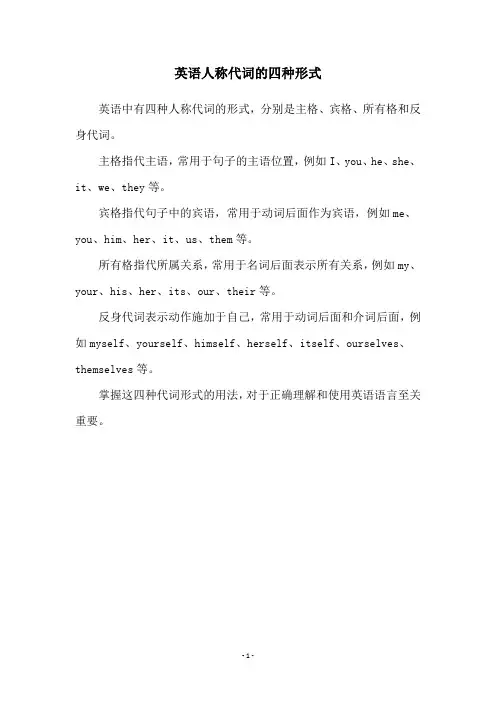
英语人称代词的四种形式
英语中有四种人称代词的形式,分别是主格、宾格、所有格和反身代词。
主格指代主语,常用于句子的主语位置,例如I、you、he、she、it、we、they等。
宾格指代句子中的宾语,常用于动词后面作为宾语,例如me、you、him、her、it、us、them等。
所有格指代所属关系,常用于名词后面表示所有关系,例如my、your、his、her、its、our、their等。
反身代词表示动作施加于自己,常用于动词后面和介词后面,例如myself、yourself、himself、herself、itself、ourselves、themselves等。
掌握这四种代词形式的用法,对于正确理解和使用英语语言至关重要。
- 1 -。
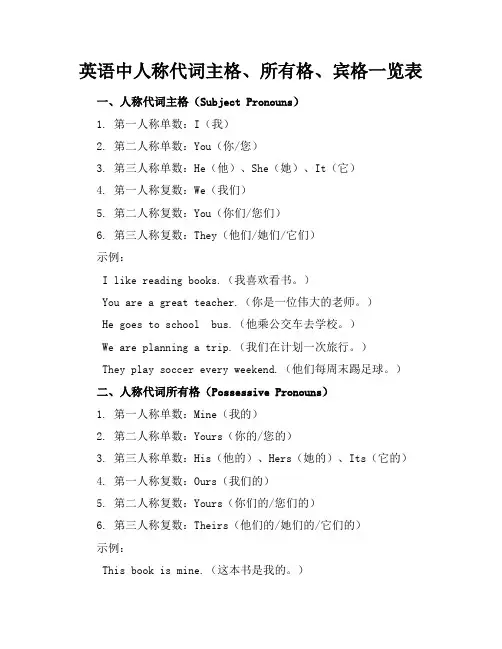
英语中人称代词主格、所有格、宾格一览表一、人称代词主格(Subject Pronouns)1. 第一人称单数:I(我)2. 第二人称单数:You(你/您)3. 第三人称单数:He(他)、She(她)、It(它)4. 第一人称复数:We(我们)5. 第二人称复数:You(你们/您们)6. 第三人称复数:They(他们/她们/它们)示例:I like reading books.(我喜欢看书。
)You are a great teacher.(你是一位伟大的老师。
)He goes to school bus.(他乘公交车去学校。
)We are planning a trip.(我们在计划一次旅行。
)They play soccer every weekend.(他们每周末踢足球。
)二、人称代词所有格(Possessive Pronouns)1. 第一人称单数:Mine(我的)2. 第二人称单数:Yours(你的/您的)3. 第三人称单数:His(他的)、Hers(她的)、Its(它的)4. 第一人称复数:Ours(我们的)5. 第二人称复数:Yours(你们的/您们的)6. 第三人称复数:Theirs(他们的/她们的/它们的)示例:This book is mine.(这本书是我的。
)Is this pen yours?(这支笔是你的吗?)That car is his.(那辆车是他的。
)The cat is hers.(那只猫是她的。
)三、人称代词宾格(Object Pronouns)1. 第一人称单数:Me(我)2. 第二人称单数:You(你/您)3. 第三人称单数:Him(他)、Her(她)、It(它)4. 第一人称复数:Us(我们)5. 第二人称复数:You(你们/您们)6. 第三人称复数:Them(他们/她们/它们)示例:She called me yesterday.(她昨天给我打电话了。
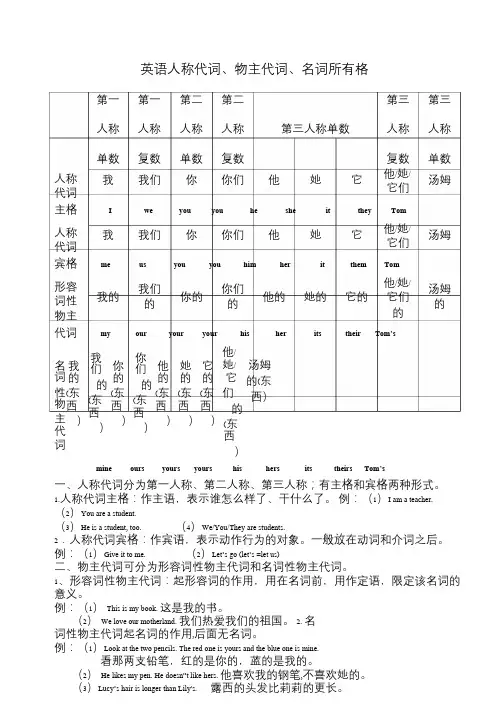
英语人称代词、物主代词、名词所有格第一第一第二第二第三第三人称人称人称人称第三人称单数人称人称单数复数单数复数复数单数人称代词我我们你你们他她它他/她/它们汤姆主格I we you you he she it they Tom人称代词我我们你你们他她它他/她/它们汤姆宾格me us you you him her it them Tom形容词性物主我的我们的你的你们的他的她的它的他/她/它们的汤姆的代词my our your your his her its their Tom’s名词性物主代词我的(东西)我们的(东西)你的(东西)你们的(东西)他的(东西)她的(东西)它的(东西)他/她/它们的(东西)汤姆的(东西)mine ours yours yours his hers its theirs Tom’s一、人称代词分为第一人称、第二人称、第三人称;有主格和宾格两种形式。
1.人称代词主格:作主语,表示谁怎么样了、干什么了。
例:(1)I am a teacher. (2)You are a student.(3)He is a student, too. (4)We/You/They are students.2.人称代词宾格:作宾语,表示动作行为的对象。
一般放在动词和介词之后。
例:(1)Give it to me. (2)Let’s go (let’s =let us)二、物主代词可分为形容词性物主代词和名词性物主代词。
1、形容词性物主代词:起形容词的作用,用在名词前,用作定语,限定该名词的意义。
例:(1)This is my book. 这是我的书。
(2)We love our motherland. 我们热爱我们的祖国。
2. 名词性物主代词起名词的作用,后面无名词。
例:(1)Look at the two pencils. The red one is yours and the blue one is mine.看那两支铅笔,红的是你的,蓝的是我的。
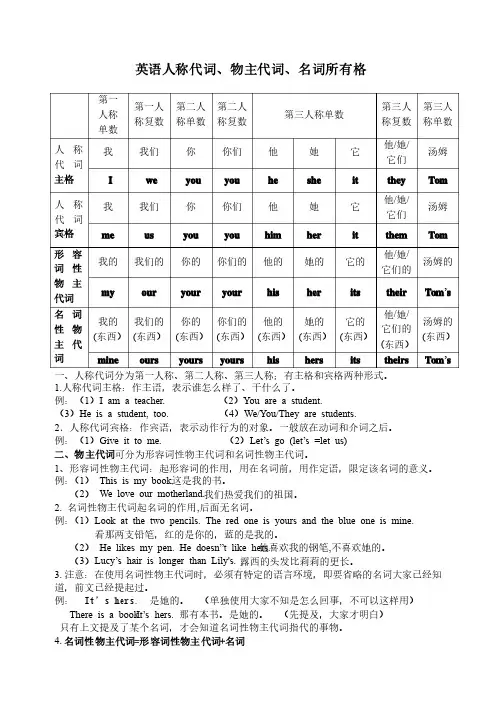
第一人称单数单数 第一人称复数称复数 第二人称单数称单数 第二人称复数称复数 第三人称单数第三人称单数 第三人称复数称复数 第三人称单数称单数 人称代词主格我 我们我们 你 你们你们 他 她 它 他/她/它们它们 汤姆汤姆 I we you you he she it they Tom 人称代词宾格我 我们我们 你 你们你们 他 她 它 他/她/它们它们 汤姆汤姆 me us you you him her it them Tom 形容词性物主代词我的我的 我们的我们的 你的你的 你们的你们的 他的他的 她的她的 它的它的 他/她/它们的它们的 汤姆的汤姆的 my our your your his her its their Tom ’s 名词性物我的我的 (东西) 我们的我们的 (东西)东西) 你的你的 (东西) 你们的你们的 (东西) 他的他的 (东西) 她的她的 (东西) 它的它的 (东西) 他/她/它们的它们的 汤姆的(东西)1.These are ( (2.Those books are . .(他们的)(他们的)3.Is this photo (你的)?(你的)?4.Is this (你的)5. (它的) 6. (她)7.The eraser is for .(她)(她) 8.Is this (她的)9.Is this bag (她的)?(她的)? 10.I don’t like .((他们)(他们) 11. (他们)12. (他们的)13.The old shoes are . .(他们的)(他们的) 14.This potato is . .((我的)(我的) 15.That tomato is .(你的)(你的) 16.This is (我的)17.That is (你的)18. 19.He will catch up with .(我们)20.The red bike is . .((他的)(他的) 21.I am worried about . .((他)(他) 22.That eraser is . (Bill 23. (我们的)(我们的) 24.These are not ( 25.The big and bright classroom is (我们的)6. Here are many dolls, which one is _________ ? ( she ) 7. I can find my toy, but where’s _________? ( you )8. Show _________ your kite, OK? (they) 9. I have a beautiful cat. _________name is Mimi. These cakes are _________. ( it ) 10. 10. Are Are Are these these these ________ ________ ________ tickets? tickets? tickets? No, No, No, ________ ________ ________ are are are not not not _________. _________. _________. ________ ________ ________ aren’t aren’t aren’t here. here. ( they ) 11. Shall _________ have a look at that classroom? That is _________ classroom. ( we ) 12. _________ is my aunt. Do you know _________ job? _________ is a nurse. ( she ) 13. That is not _________ camera. _________is at home. ( he ) 14. Where are _________? I can’t find _________. Let’s call _________ parents. ( they )15. Don’t touch _________. _________ not a cat, _________ a tiger!(it )16. _________ sister is ill. Please go and get _________. ( she ) 17. _________ don’t know her name. Would you please tell _________. ( we )18. So many dogs. Let’s count _________. ( they )19. I have a lovely brother. _________ is only 3. I like _________ very much. ( he ) 20. May I sit beside _________? ( you ) 21. Look at that desk. Those book are on _________. ( it )22.The girl behind _________ is our friend. (she ) 23. There is a letter for ________ (she) mother. 24.That is _____ (she ) coat. The coat is red. ______ (its)is a new one. 25. Whose pens are these? _______(their) are ______ (we). 26.Give _______(he) a toy, please. 27.________(we) eyes are black. _______ (us) come from Japan. 28.Tim and Bill are twins. _______ (their )are from England. _________ (them) parents are teachers in No 6 school. 29.Give the book to __________(I ). 30. These books are __________(we). 三、填上正确的人称代词和物主代词三、填上正确的人称代词和物主代词1. _____ is my friend. 他是我的朋友。

一、人称代词分为第一人称、第二人称、第三人称;有主格和宾格两种形式。
1.人称代词主格:作主语,表示谁怎么样了、干什么了。
例:(1)I am a teacher.(2)You are a student.(3)He is a student, too.(4)We/You/They are students.2.人称代词宾格:作宾语,表示动作行为的对象。
一般放在动词和介词之后。
例:(1)Give it to me.(2)Let’s go (let’s =let us)二、物主代词可分为形容词性物主代词和名词性物主代词。
1、形容词性物主代词:起形容词的作用,用在名词前,用作定语,限定该名词的意义。
例:(1) This is my book. 这是我的书。
(2) We love our motherland. 我们热爱我们的祖国。
2. 名词性物主代词起名词的作用,后面无名词。
例:(1)Look at the two pencils. The red one is yours and the blue one is mine.看那两支铅笔,红的是你的,蓝的是我的。
(2) He likes my pen. He doesn”t like hers. 他喜欢我的钢笔,不喜欢她的。
(3)Lucy’s hair is longer than Lily's. 露西的头发比莉莉的更长。
3. 注意:在使用名词性物主代词时,必须有特定的语言环境,即要省略的名词大家已经知道,前文已经提起过。
例:It’s hers. 是她的。
(单独使用大家不知是怎么回事,不可以这样用)There is a book. It’s hers. 那有本书。
是她的。
(先提及,大家才明白)只有上文提及了某个名词,才会知道名词性物主代词指代的事物。
4. 名词性物主代词=形容词性物主代词+名词名词性物主代词在一定情况下可以用“形容词性物主代词+名词”来转换;有时为避免重复使用名词,也可用“名词性物主代词”来代替“形容词性物主代词+名词”的形式。

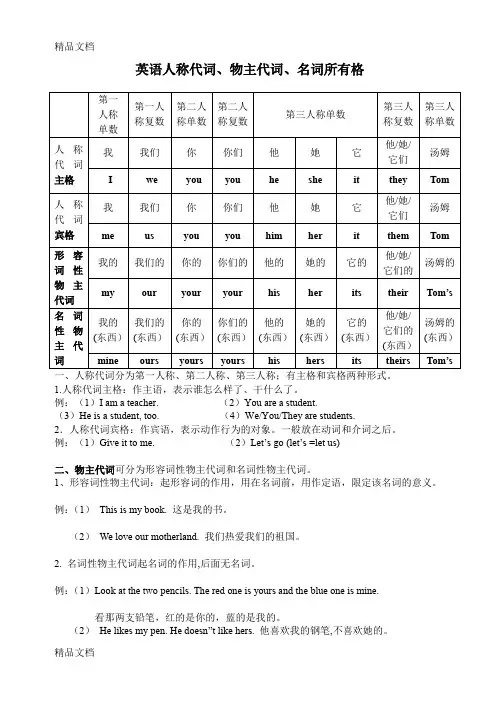
英语人称代词、物主代词、名词所有格1.人称代词主格:作主语,表示谁怎么样了、干什么了。
例:(1)I am a teacher. (2)You are a student.(3)He is a student, too. (4)We/You/They are students.2.人称代词宾格:作宾语,表示动作行为的对象。
一般放在动词和介词之后。
例:(1)Give it to me. (2)Let’s go (let’s =let us)二、物主代词可分为形容词性物主代词和名词性物主代词。
1、形容词性物主代词:起形容词的作用,用在名词前,用作定语,限定该名词的意义。
例:(1)This is my book. 这是我的书。
(2)We love our motherland. 我们热爱我们的祖国。
2. 名词性物主代词起名词的作用,后面无名词。
例:(1)Look at the two pencils. The red one is yours and the blue one is mine.看那两支铅笔,红的是你的,蓝的是我的。
(2)He likes my pen. He doesn”t like hers. 他喜欢我的钢笔,不喜欢她的。
(3)Lucy’s hair is longer than Lily's. 露西的头发比莉莉的更长。
3. 注意:在使用名词性物主代词时,必须有特定的语言环境,即要省略的名词大家已经知道,前文已经提起过。
例:It’s hers. 是她的。
(单独使用大家不知是怎么回事,不可以这样用)There is a book. It’s hers. 那有本书。
是她的。
(先提及,大家才明白)只有上文提及了某个名词,才会知道名词性物主代词指代的事物。
4. 名词性物主代词=形容词性物主代词+名词名词性物主代词在一定情况下可以用“形容词性物主代词+名词”来转换;有时为避免重复使用名词,也可用“名词性物主代词”来代替“形容词性物主代词+名词”的形式。
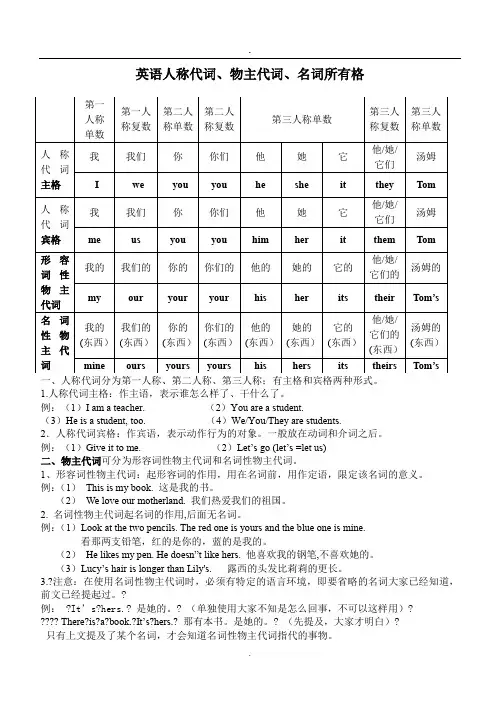
英语人称代词、物主代词、名词所有格1.人称代词主格:作主语,表示谁怎么样了、干什么了。
例:(1)I am a teacher. (2)You are a student.(3)He is a student, too. (4)We/You/They are students.2.人称代词宾格:作宾语,表示动作行为的对象。
一般放在动词和介词之后。
例:(1)Give it to me. (2)Let’s go (let’s =let us)二、物主代词可分为形容词性物主代词和名词性物主代词。
1、形容词性物主代词:起形容词的作用,用在名词前,用作定语,限定该名词的意义。
例:(1)This is my book. 这是我的书。
(2)We love our motherland. 我们热爱我们的祖国。
2. 名词性物主代词起名词的作用,后面无名词。
例:(1)Look at the two pencils. The red one is yours and the blue one is mine.看那两支铅笔,红的是你的,蓝的是我的。
(2)He likes my pen. He doesn”t like hers. 他喜欢我的钢笔,不喜欢她的。
(3)Lucy’s hair is longer than Lily's. 露西的头发比莉莉的更长。
3.?注意:在使用名词性物主代词时,必须有特定的语言环境,即要省略的名词大家已经知道,前文已经提起过。
?例:?It’s?hers.? 是她的。
? (单独使用大家不知是怎么回事,不可以这样用)? ???? There?is?a?book.?It’s?hers.? 那有本书。
是她的。
? (先提及,大家才明白)?只有上文提及了某个名词,才会知道名词性物主代词指代的事物。
4.?名词性物主代词=形容词性物主代词+名词??名词性物主代词在一定情况下可以用“形容词性物主代词+名词”来转换;有时为避免重复使用名词,也可用“名词性物主代词”来代替“形容词性物主代词+名词”的形式。